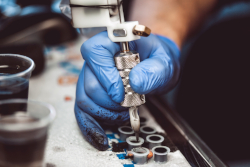Reducing Exposure
Risks Associated with Tattooing
Tattooing involves several health risks, primarily due to the invasive nature of the procedure, where needles puncture the skin to apply ink. One of the most significant risks is infection, particularly from bacteria and viruses that can be introduced into the body during the tattooing process.
With the rise of antibiotic-resistant bacteria like Methicillin-resistant Staphylococcus aureus (MRSA), it’s crucial for tattoo artists to follow strict hygiene and sterilization practices. MRSA infections are particularly concerning because they are difficult to treat and can lead to severe health complications.
The increased prevalence of MRSA infections linked to tattooing underscores the need for advanced sterilization techniques and thorough client health assessments before tattooing begins.
Allergic reactions to tattoo inks, particularly those with red pigments, have become a growing concern, as they can cause persistent skin issues like granulomas or keloids long after the tattooing process is complete. Recent research underscores an increase in these allergic reactions, emphasizing the importance for tattoo artists to thoroughly consult with clients to identify any potential allergies before beginning their work.
Knowledge Check Choose the best answer for the question.
2-1. Why is MRSA a significant concern in the tattooing process?
You forgot to answer the question!

